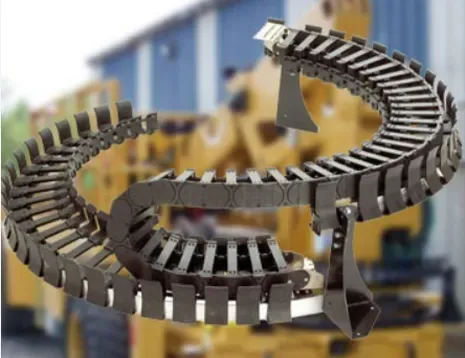cable drag chain
Understanding Cable Drag Chains Essential Components for Efficient Machine Operation
In the realm of industrial automation and robotics, the efficient management of cables and hoses is a crucial factor in ensuring smooth operation and longevity of the machinery. One of the most effective solutions for organizing and protecting these cables is the cable drag chain. This specialized component not only secures cables but also allows for their smooth movement, minimizing wear and tear and preventing tangling. In this article, we will explore the functionality, types, installation, and benefits of cable drag chains in detail.
What are Cable Drag Chains?
Cable drag chains, also known as energy chains or cable carriers, are flexible mechanisms designed to hold and guide electrical cables, hydraulic hoses, and pneumatic tubing in moving applications. Commonly used in CNC machinery, robotics, conveyor systems, and various automated equipment, these chains allow components to move freely while keeping cables neatly organized.
The design of a drag chain typically consists of a series of interconnected links that form a channel through which cables can be routed. These links can be adjusted to accommodate varying lengths and types of cables, making them versatile for different applications. Drag chains can be mounted on a fixed part of the machinery while the other end moves with the mobile component, providing a continuous loop for cable routing.
Types of Cable Drag Chains
Cable drag chains come in various shapes, sizes, materials, and designs to cater to different industrial needs. The two main categories are
1. Open Cable Drag Chains These chains have a simple design allowing for easy access to the cables and tubing inside. They are ideal for environments where frequent maintenance and adjustments are necessary. Open drag chains are useful in applications that require quick cable changes or inspections.
2. Closed Cable Drag Chains These chains offer complete protection for the cables within. They are designed to prevent the ingress of dirt, dust, and other contaminants, making them suitable for harsh environments. Closed chains are often used in sophisticated machinery that operates in demanding conditions, such as in the automotive or aerospace industries.
Materials used in manufacturing cable drag chains include plastic, steel, and aluminum. Plastic chains are lightweight, corrosion-resistant, and suitable for general applications, whereas steel and aluminum chains provide enhanced strength and durability for heavy-duty environments.
Installation and Maintenance
cable drag chain

Installing a cable drag chain involves mounting it to the machinery's fixed and moving parts
. The process typically includes the following steps1. Planning Determine the required length and type of drag chain based on the application. Consider the movement path and the number of cables that need to be housed.
2. Mounting Use appropriate brackets and fasteners to secure the fixed base of the drag chain. Ensure it is aligned correctly to allow for smooth movement.
3. Routing Carefully route the cables through the drag chain, ensuring they are not pinched or kinked. Leave extra length for movement at each end.
4. Testing Once installed, conduct tests to ensure the drag chain operates smoothly without friction or resistance.
Maintenance of cable drag chains is minimal but essential. Regular inspections for wear and tear, cleaning to remove debris, and ensuring cable integrity can prolong the lifespan of both the chains and the cables they house.
Benefits of Using Cable Drag Chains
The advantages of incorporating cable drag chains into machinery are numerous
- Cable Protection Drag chains protect cables from damage due to friction, abrasion, and environmental factors, thereby extending their lifespan. - Organized Management They prevent tangling and disorganization of cables, facilitating easier maintenance and replacement. - Increased Mobility Drag chains allow for smooth movement of cables as the machinery operates, ensuring that the movement of components is not hindered. - Enhanced Safety By keeping cables securely in place, drag chains reduce the risk of tripping hazards in busy work environments. - Cost-Effectiveness Investing in drag chains can lead to reduced downtime and maintenance costs due to fewer cable replacements and repairs.
In conclusion, cable drag chains play a vital role in modern industrial applications, ensuring that cables and hoses are managed efficiently and effectively. Their diverse designs, ease of installation, and numerous benefits make them an indispensable component in many automated systems, contributing to the overall productivity and safety of machinery. For industries focused on efficiency and reliability, integrating cable drag chains into their equipment is a decision that truly pays off.








